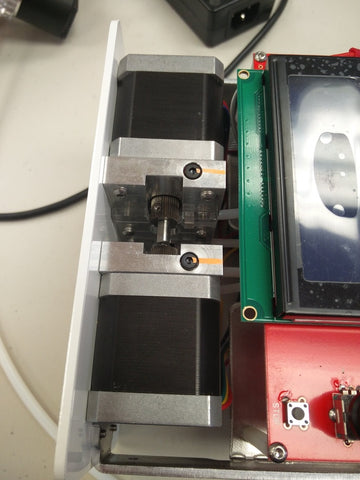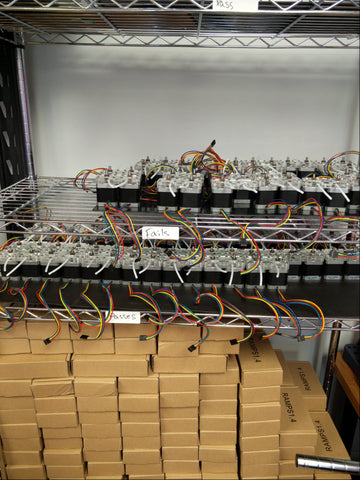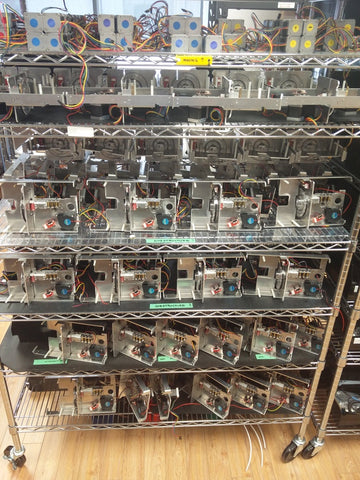Hey Team,
As you might have guessed from the title….. we’re moving forward with shipping the first batch!
Delivery day has arrived, and we have 40 beautiful Palettes to show for it. This day has not arrived without its challenges – but after more than two years of development we have a product that we’re proud to be shipping out.
We’re going to give you a look at what went into the final steps of Palette’s manufacturing and quality control processes, as well as what the final challenges we faced were…. But before that we think it’d be interesting to take a step back and give you a snapshot of where we started two years ago.
Check out the below video of our first prototype, from July 2014:
And below, a video of our production facility running five prints at once:
We’ve done our best to document the evolution of Palette and Mosaic both on our updates, and on our blog (Link).
We’ve gone through every type of challenge and issue that hits a manufacturing company – supplier issues, quality control issues when moving to manufacturing, and product performance issues when progressing to production.
In this update, we’re going to cover the biggest improvements from our operation in March, to our operation today. We’ll talk you through our QC processes to help you understand what your Palette goes through in our facility. Finally, we’ll lay out the full delivery timelines, and when you should expect your Palette to show up.
So, what’s changed?
When we first began production in March, we were having quality issues – but the bigger problem was that the issues couldn’t be solved quickly.
In March and April we had an overflowing shelf of Palettes that weren’t working, with no clear steps to get them working again. We’d setup Palettes, and the default was that they would fail. The ones that worked properly worked relatively well; however, these were few and far between.
Today – not only are we having a lot fewer issues with our Palettes, but the issues we’re having are typically fixable in minutes. The FAT (Final Acceptance Test) that we run today is 4x longer than back in March, and our pass rate is multiples higher.
In our June Post we covered the multi-day all hands meeting we had. This meeting froze all work that was unrelated to Palette reliability and repeatability.
Over the months of June and July we were working in three teams:
1) Drive Team
2) Splice Team
3) Calibration Team
On a high level, each team accomplished the following things:
1) Drive Team:
a. Completely removed slipping and skipping in our drive systems, two of our biggest quality control and manufacturing issues.
b. Decreased assembly and testing time (on a per drive basis) from 2+ hours, to ~10 minutes.
c. Increased long term reliability, allowing Palettes to run thousands of splices with no drive degradation.
2) Splice Team:
a. Removed issue of gap splices, and bulging splices (accomplished via opto homing)
b. Increased splice reliability from 1 in 80 fail, to 1 in 350+.
c. Found and fixed manufacturing tolerance issue with hot tool
3) Calibration Team:
a. New ping detection algorithm, increasing ping detection from ~60% to 99%+
b. New correction algorithm to account for parts with wildly varying extrusion amounts
c. Improved firmware and software – including manual control, hot tool cleaning, parametric transition towers, and many more.
All of this was accomplished in the span of two months.
In August, we faced a number of process related challenges. There’s a really big difference between getting five Palettes to work, and making five Palettes that work – every. single. day.
The first few weeks were full with challenges related to repeatedly tuning our adjustable drive systems.
Below is a picture of our tuning rig:

The adjustable drives are tuned on the basis of torque. Torque is a measure of drive gear bite in, which is determined by the distance the drive gear and the idler bearing are away from each other.
We use a stepper motor mounted to a geared jig to pull a force gauge, and record the readings from this tool.
We convert the readings to torques and based on them, tighten or loosen the adjustment bolt to get the torque into the correct range.

By tuning the drives based on torque level, we’re able to control slipping and skipping better than we’ve ever been able to do before.
We used to have ~50% failed drives – drives that would have to go directly into a waste bin. Since making the switch to adjustable constant distance aluminum drives, this waste rate has decreased to <5%.
That means the Fail shelf for our old drives that you see below is no longer overflowing:

Basically, what all of this means is a much more reliable, efficient manufacturing operation.
To pull a quote from our April Shipping Post:
“Now, the hard truth – 20% of our units passed our QC processes. We built a total of ten units, and two of them were cleared at the end of the week.”
Now, when we make ten units, about 5 of them will pass on the first try. The other five will be tuned, and 4 of them will pass the second time around. The last one will usually pass the third time around.
Out of the 58 we’ve made so far, check out our current Tuning Shelf:

Five out of 58 waiting to be tuned. The other 53 are either passed, or in our QC process.
Quality Control
We’ve mentioned QC a lot in our posts, we’d like to give you a look at what our QC processes look like to help you understand what your Palette goes through before it leaves our facility.
There are a number of tests we run called ICTs (In-Circuit Tests), which we covered in one of our April Post. ICTs help find early failures in individual components, our drive systems, and in our electronics tray.
Once a Palette has been fully assembled, our manufacturing team runs through the Final Acceptance Checklist, pictured below:

This checklist ensures that all the screws are tightened, the internal metal structure is flush with itself, and the appropriate QC marks are on the specific sub-structures. This checklist allows us to catch errors made in the assembly process before Palettes enter the QC room.
Stage 1: Splice Testing
Stage 2: Print Testing



And the result?

This picture is the first batch of Palettes, waiting to be cleaned, covered, and boxed. Once Palettes are at this stage, they’re ready to go out the door.
We do occasionally spot check them, but from what we’ve seen there haven’t been any real inconsistencies in performance from the QC checks to the spot checks.
So, what happens now?








As always, if you have any questions please feel free to comment below!
-Mosaic.
